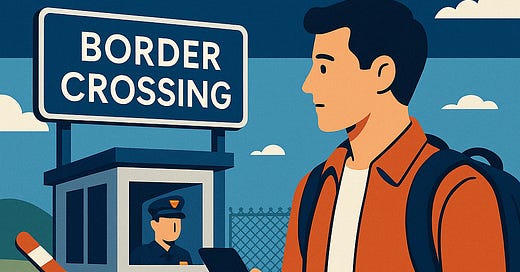Traveling Smart: Safeguard Your Devices and Digital Privacy at Border Crossings
What You Don’t Know Can Be Used Against You—Here’s How to Cross Borders Without Compromising Your Digital Life
In an era where your phone can reveal more about you than your passport, protecting your digital privacy during international travel is more important than ever. Smartphones, tablets, cameras, and laptops carry sensitive information — personal messages, photos, political opinions, or social media activity — all of which could become a problem at the border.
This power gap matters for everyone, but especially for journalists, activists, business travelers, and anyone who values personal privacy. The protections of the Fourth Amendment weaken dramatically at the border. If you're not prepared, your device could reveal far more than you intended.
Fortunately, there are several practical strategies anyone can use to minimize exposure and protect their data when re-entering the United States.
What You Should Know About CBP
At border checkpoints, CBP officers are allowed to inspect electronic devices under what’s known as the border search exception. This legal loophole lets agents search and even detain your electronics without probable cause. While “advanced searches” (those requiring external devices or tools) have slightly more oversight, even basic “manual” inspections can expose your photos, browser history, and cloud connections.
In some cases, travelers are asked to unlock devices, provide passwords, or explain content. Refusing may result in the seizure of your device or extended questioning—but cooperating doesn't guarantee your privacy is respected either.
1. Take Only What You Need
Before you pack, ask yourself: Do I really need this device on this trip?
If not, leave it behind. Traveling light — digitally and physically — gives you more control. Consider using a travel-only phone, tablet, or laptop that holds no sensitive content.
Action Step:
Purchase a low-cost, clean device strictly for travel (if possible).
Only install the essentials: travel documents, maps, a local SIM, and apps needed for your trip.
Don’t connect your personal accounts.
2. Use the Cloud Strategically (But Keep It Separate)
Avoid carrying politically sensitive content or private materials on your devices. Instead, move important data to a secure, encrypted cloud service before travel.
Even better: Use a dedicated travel-only email address and cloud account that are not linked to your real name, personal devices, or social media accounts.
Action Step:
Create a new ProtonMail or Tutanota email just for travel.
Store necessary documents in a travel-only encrypted cloud storage account (e.g., Proton Drive, Tresorit, or SpiderOak).
Sign out of and remove all personal accounts (email, cloud, social media) from your devices before customs.
Use your new travel email and cloud account
You can add your personal accounts back when you are home
3. Encrypt Everything
Encryption keeps your data safe even if someone gains physical access to your device. Most modern devices support full-disk encryption — all you need to do is turn it on.
Action Step:
iPhone: Use a strong passcode (not Face ID or Touch ID) and enable “Erase Data” after 10 failed attempts.
Android: Go to Settings > Security and enable full-disk encryption.
Laptops: Use FileVault (macOS) or BitLocker (Windows).
Be sure to completely power down your devices before arriving at customs. This forces the use of a passcode for access.
4. Wipe and Reinstall — Don’t Just Delete Apps
Deleting social media or messaging apps before customs isn’t enough. Border agents using forensic tools can recover deleted data, including messages, photos, and login information.
A stronger approach is to wipe your device entirely before your trip and reinstall only the apps you’ll need. Avoid installing or connecting any personal email, social media, or messaging apps until after you’ve cleared customs.
Action Step:
Back up your device securely to an encrypted cloud service before travel.
Perform a factory reset on your phone, tablet, or laptop.
Reinstall only essential travel apps (maps, language tools, itinerary, etc.).
Do not log in to personal social media, email, or cloud accounts until safely past inspection.
This creates a digital “burner” environment that limits risk and protects your true digital life.
5. Create a Guest or Travel Account on Your Device
If you must bring your personal laptop or tablet, create a separate user profile with only neutral, travel-related content. Use this account when passing through customs.
Action Step:
On macOS or Windows, create a new user account with no access to your main files.
Log into this clean account before arrival and keep your main account encrypted and locked.
6. Turn Off Face ID and Fingerprint Unlocking
Biometric access is convenient, but risky at the border. Agents can compel you to unlock with your face or finger — but not with a passcode.
Action Step:
Disable biometric unlocking before customs.
Power down your device completely — this requires a passcode to unlock on reboot.
7. Use Privacy-Focused Tools for Travel
When using public Wi-Fi, always encrypt your connection with a VPN. Also avoid using browsers or apps that track your activity.
Action Step:
Use trusted VPNs like Mullvad or Proton VPN.
For browsing, try Brave, DuckDuckGo, or Firefox Focus.
These tools protect you abroad and minimize exposure if your device is inspected.
8. Know Your Rights — And Stay Cool
CBP agents can inspect and even confiscate your device, but you’re not obligated to answer questions about your political views or online activity. If questioned, remain calm, polite, and assertive.
Action Step:
If asked about your political beliefs, you can respond with:
“I prefer not to answer questions about my political opinions. Am I free to go?”
If a device is seized:
Ask for a receipt.
Get the agent’s name and badge number.
Contact a legal expert or the EFF afterward.
Final Thoughts
In a time when digital privacy is under constant threat, protecting yourself at the border is an act of self-respect. Whether you’re a journalist, activist, or simply politically aware, these steps can help ensure your digital life stays yours.
Travel light. Travel encrypted. Travel smart.




